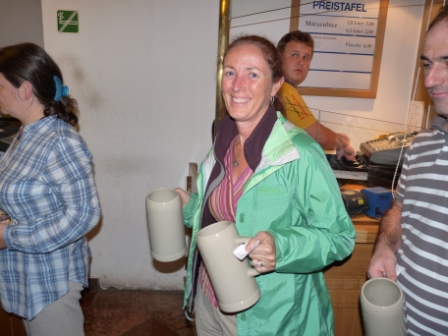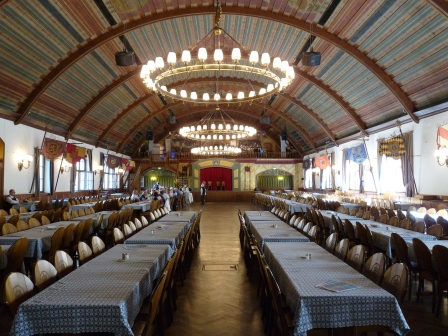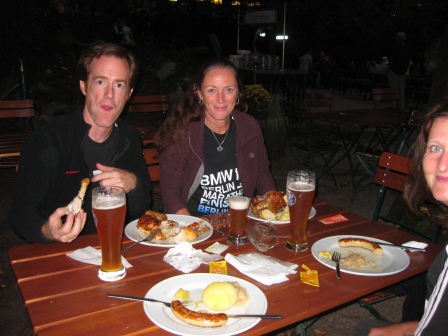Bavaria is all the stereotypical images of Germany rolled into one. Lederhosen, oom-pah-pah-bands, sausage eating, and especially beer-drinking. They say when in Rome…
The Czech Republic drinks the most beer per capita in the world (159 litres per year) with Germany a respectable third (110 litres per year) after Ireland. However, if Bavaria were its own country, they would beat out the Czechs by drinking an astonishing 170 litres per year! Although Canada fashions itself a beer drinking country (“I am Canadian”), we are light-weights compared to these champions. Canada ranks in 22nd place drinking only 68.3 litres per person per year. Tell that to your accuser the next time they criticize you for drinking too much beer! Source: Wikipedia – Beer consumption by country
The monks of Bavaria are the traditional brewers of beer here, with secret recipes being handed down for hundreds of years. They still own some of the breweries and beer halls today. The first beer hall we visited was Augustiner Brau in Salzburg, Austria (not technically Bavaria, but close by). It has 4 huge rooms, one of which is non-smoking, which seat up to 2800 people in total. This beer house was founded by the Augustinian monks, and the image of Jesus adorns each room (perhaps they’re hoping to keep intoxicated visitors on their best behaviour). Beer is poured directly from large casks to thirsty patrons waiting in line with empty crockery steins.


Bavaria, in the southern part of Germany, has a plethora of beer halls (known as “Brauhaus”). Many of these are hundreds of years old with rich histories. The most famous of Bavarian beer halls is the Hofbräuhaus in Munich. Founded by the Duke of Bavaria, Wilhelm V, they have been serving beer there since 1589 (that’s 423 years of continuous beer drinking!) In the early days, it was a place for men only. It is doubtful that women would have wanted to participate anyhow due to the cursing and the fighting and the vomiting. Also, the tables had troughs underneath so the guys could urinate without leaving their seat, allowing a near continuous flow of beer in and out. Another example of German ingenuity and practicality. In the early 20th Century the upper floor of the Hofbräuhaus was also the meeting place of the fledgling Nazi party, and on February 24, 1920, Adolf Hitler proclaimed the twenty-five theses of the National Socialist program at the Hofbräuhaus, which reconstituted the German Workers’ Party as the National Socialist German Workers’ Party, also known as the Nazi Party. Today the Hofbräuhaus is primarily filled with tourists drinking expensive beer in large steins.
Munich is home to the largest beer gardens I’ve ever seen. Every park seems to have one or more. Beer gardens of up to 7000 people are commonplace. In order to be an official beer garden, three things are required — it must serve beer, it must be in Bavaria, and it must have chestnut trees. Bier gardens were traditionally located on top of the underground cellars where the beer kegs were stored. People drank beer there because that’s where the beer was! The casks were winched up from below, tapped on the spot, and people stood around drinking beer setting their glasses on the beer kegs (it was only later that tables and chairs were added). Why chestnut trees you ask? Chestnut trees have broad leaves and shallow roots and were planted on top of the underground beer cellars to keep them cool in summer.

The disadvantage of Chestnut trees is that they randomly release hazardous projectiles each year around this time. Diane was hit on the hand in our first week here resulting in a bruise. And one night in Munich she sustained a direct hit into her beer glass which exploded sending shards of glass into our meals.

A nice thing about beer gardens (other than the beer of course) is that you’re allowed to bring your own food. This is done to appease the local merchants who know that the beer gardens attract so many people that to restrict outside food would affect their sales. Presumably the beer gardens are making lots of money from the beer anyhow. 500 ml and 1 Litre sell for about $5 and $10 respectively with no price advantage for buying the larger size.
The Bavarian Purity Law of 1516 (the Reinheitsgebot) allowed beer made in Bavaria to contain only 3 things — water, barley, and hops. German breweries continue to adhere to a slightly expanded version of this law today (wheat can now be used and a couple of additional ingredients are allowed depending on the type of beer being brewed). This law was originally put in place to prevent price competition between bakeries and brewers for wheat. The restriction of beer grains to barley was meant to ensure sufficient supply of wheat for baking bread. Hops adds flavour to beer but also acts as a natural preservative, and it was required by the Purity Law to prevent other inferior types of problematic preservatives from being used (for example soot or stinging nettles). Those of you with a science or brewing background may notice that a critical component of beer is missing. That’s because it was not until the 1800’s that Louis Pasteur discovered the role of microorganisms in fermentation, so it was not known that YEAST was a required ingredient of beer. However brewers traditionally added some sediment into each batch from the previous fermentation which provided the necessary organisms. If this was not available they would put the beer in multiple vats allowing natural yeast to inoculate the brew.
The undisputed champion of beer drinking locales is the city of Munich which, in addition to Oktoberfest, has beer festivals for over 30 weeks each year. The current pope, in addition to re-distributing child abusers, was Cardinal in Munich in the 1990’s and was known to drink beer with the locals. Because the tables are usually full, we’ve found the beer halls to be an excellent place to talk with the local people. What better way to interact with the locals than over a big stein of beer!

Hi guys.
I think you both may add a few inches to your “arms” judging from the size of the beer steins!!
Really good to hear from you again. ENJOY!! You deserve it!!
Take care.
Moe & Arlene
nice jugs